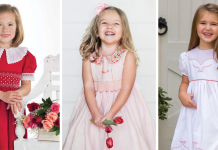
by CONNIE PALMER
Written by AMELIA JOHANSON
Photography by JENNIFER TARKINGTON and MAC JAMIESON
When Martha Pullen’s first great-grandbaby, Wylder, son of her first granddaughter, Morgan, was born last March, the heirloom sewing community as a whole began to speculate about the baby’s Christening gown. After all, if there were such a thing as heirloom sewing royalty, Martha would undoubtedly be the queen, and the new little prince was bound to be baptized and presented to his church family wearing something glorious—and glorious it is. The most ornate gown and bonnet Connie Palmer has made to date are the very definition of “dripping with lace.”
“As much as I wanted to make the gown, I knew it had to be Connie,” said Martha. “Once I saw the ideas that Morgan was gathering, I knew Connie was the only designer to pull them all together and do justice to my first great-grandbaby’s Christening gown. She is the number one heirloom seamstress and designer of Christening gowns in the world today, period.”

Morgan posted her ideas for the gown on Pinterest. She grew up modeling in the pages of Sew Beautiful magazine, surrounded by lovingly made heirlooms, but today it’s a social media world. So rather than tear pages from past issues or try to describe to Connie what she envisioned, she scoured the internet and pinned a collection of gowns and vintage garments to an inspiration board. None of the gowns were quite right—a panel on one might have caught her eye, a sleeve on another—but she loved several elements and wanted to bring them together to create a spectacular gown of white batiste trimmed in ecru.
“I’d never want to copy anyone else’s work, but it was so helpful to have the Pinterest pictures to flip through what (Morgan) liked,” said Connie. “It’s really important for me to know what a person likes; if she doesn’t like pintucks or puffing, then we won’t include that.”
In Morgan’s case, puffing and pintucks weren’t an issue. In fact, they were requested, along with lots and lots and lots of lace eagerly furnished by Martha from the antique yardage she’s collected over the years. Connie didn’t even guesstimate how much she used to make the 50″-long gown. There are 12 rows of insertion and 10 rows of gathered edging down the center front skirt panel, which is trimmed down each side with a wider gathered edging.
 More insertion and gathered edging zigzags up the left and right front panels, and single rows of vertical insertion, flanked by flat edging, separate the nine narrow panels that make up the back of the gown. The sides of the front yoke—several strips of lace overlaid and stitched or joined with entredeux—angle toward a center panel cut to elegantly silhouette a Trinity embroidery. More gathered lace outlines the Trinity shape and continues around the neckline. A double row of the wide gathered edging on top of a section of lace strips finishes the front panel, a single row edges each sleeve, and finally, flat edging is applied to the wide fabric ruffle, which is joined to the bottom of the gown with entredeux.
More insertion and gathered edging zigzags up the left and right front panels, and single rows of vertical insertion, flanked by flat edging, separate the nine narrow panels that make up the back of the gown. The sides of the front yoke—several strips of lace overlaid and stitched or joined with entredeux—angle toward a center panel cut to elegantly silhouette a Trinity embroidery. More gathered lace outlines the Trinity shape and continues around the neckline. A double row of the wide gathered edging on top of a section of lace strips finishes the front panel, a single row edges each sleeve, and finally, flat edging is applied to the wide fabric ruffle, which is joined to the bottom of the gown with entredeux.
“There must be more than 10 yards of lace in the front panel alone; just thinking about it could make a sane person go crazy,” joked Martha. “I had been saving a lot of antique lace that I picked up in France, England, and Australia over the years, and I still had to contact a friend in France to order some additional wide edging.”
Add to all the lace, the horizontal pintucks and puffing strips down the center front, the long vertical pintucks to the inside of the zigzagged treatments, the four exquisite silk ribbon flowers (frou-frous) at the top and bottom of the front lace panel, and touches of machine embroidery that are both elegant and meaningful, and you’re looking at an heirloom gown of sheer perfection.
The Trinity Cross Connie plucked from The Embroidery Club 2019 and embroidered on the bodice signifies the affirmation of the Christian faith, but it is also a nod to Trinity United Methodist Church in Birmingham, where Wylder was baptized on March 14. Simple “G” monograms (for the baby’s surname), created in embroidery software, are surrounded by floral designs embellish the center of the short sleeves, also motifs from The Embroidery Club 2019. (NOTE: The cross and other motifs are found in the Regal Flowers, Vines & Frames collection of The Embroidery Club 2019.)
“It was the most beautiful sleeve, just a simple monogram surrounded by other embroidered shapes. I’d never seen a sleeve like it,” said Martha.
 Connie used a very fine batiste to create the individual strips of puffing, knowing the weight it would add to the gown if she used a traditional batiste. The rest of the gown is Nelona, as is the slip, which has a dee lace-edge ruffle that serves to hold out the full skirt.
Connie used a very fine batiste to create the individual strips of puffing, knowing the weight it would add to the gown if she used a traditional batiste. The rest of the gown is Nelona, as is the slip, which has a dee lace-edge ruffle that serves to hold out the full skirt.
Throughout the process, which Connie admits amounted to more hours than she’d ever spent constructing a gown, she collaborated with Morgan and Martha, sending pictures of the sections as she completed them.
“It is definitely one of the most challenging gowns I have ever made, because I had to marry all the pieces. I knew I wanted side panels, but there was so much on the front that something had to be on the back. I needed to bring the design around without it being too ornate,” she said. “Then, of course, I knew I needed something on the bottom. I actually ended up taking off the front ruffle at one point and putting it back on. It was just this whole lesson in balance.”
BONNET
By all accounts, Wylder adored his bonnet. Babies pretty typically tug off hats the instant they make contact with their little heads, but Wylder was content to let Morgan tie the bonnet around his chin, and he happily relished in the attention it brought. It simply wouldn’t do to pair a simple design with such an elaborate gown. Connie created a headpiece of puffing pinstitched to a strip of insertion lace on either side.
She let the lining serve to finish the front edge for a more tailored approach and added an edging flourish to the back. Joined to the loose edge of the insertion strip with entredeux, the edging floats free around the crown that is encircled with more entredeux and embellished with a “G” matching the sleeve monogram.
The bonnet ties, which match the silk ribbon used for the frou-frous on the gown, are secured to each side and topped with a beautiful three-point bow.
 BLANKET
BLANKET
Never knowing what March weather will bring, Connie also created a baby blanket to complete the ensemble. A center quilted square is bordered with flat fabric and framed with narrow lace insertion. She embellished the right corner with the same fancy band treatment as is found on the front panel of the gown.
She embroidered Wylder’s initials in the corner, and around the border added the verse from Matthew 19:14 (ESV) “Let the little children come to me and do not hinder them, for to such belongs the kingdom of God.”
A traditional quilt binding finishes the special little blanket.
TO SEE MORE PHOTOS OF THIS GOWN, check out the original article in our Autumn 2021 issue of Classic Sewing magazine.
COMING IN THE HOLIDAY 2021 ISSUE—Connie, a master of heirloom sewing, will share a series of how-to articles on her favorite techniques used on Wylder’s gown.
SUBSCRIBE TO CLASSIC SEWING MAGAZINE! Each issue is filled with projects, how-tos, garment patterns, reviews and more!





